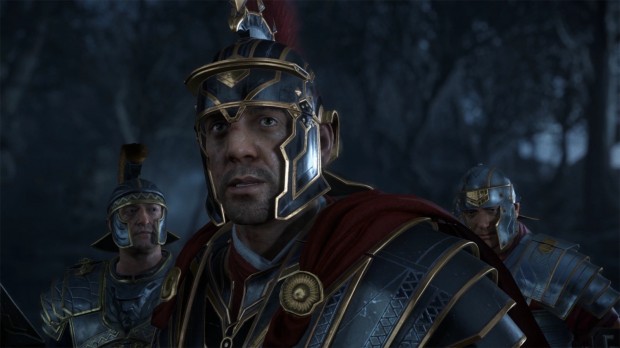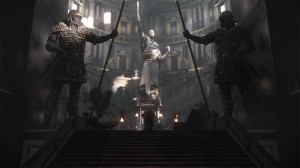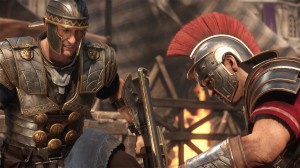Hands-on with Ryse: Son of Rome
- Updated: 6th Nov, 2013

In an early section of Ryse, I, Marius Titus, Son of Rome, had to escort my father to safety as our compound was sacked by barbarian invaders. We raced through the hallways and atria, slashing and stabbing through the hordes. Eventually we came to a raised 20-foot drawbridge beside half a dozen docked rowboats.
“You must lower the drawbridge, my son” said my father, and so I backtracked through the corridors and found my away along a raised platform that ran next to the bridge but some 10 feet above it. I crossed the river to get a clear shot at the rope that held the bridge up and neatly severed it with a well-placed pilum.
“Well done!” my father shouted as he ran past the rowboats and across the short bridge. I carried on along my platform, slipping through the barricade by pushing a cart out of the way and was reunited with my father at the far end of the passage.
Why didn’t my father and I both just climb through the barricade instead of waiting at the exposed drawbridge? Why didn’t we take the boat? What was the point of this whole scene?
I have no idea. Ryse is that sort of game. You run around, follow orders and try not to think too hard about the absurdity of it all.
I spent roughly an hour playing the first few chapters at a recent Xbox showcase and have come to the conclusion that Ryse is a game designed for looking at, not for playing. It’s absolutely beautiful and very showy. Firing ballistae into a crowd is a great early setpiece and flinging a pilum through your enemies is a handy way to take out archers from a distance. The Roman architecture towers above you, the fires from the barrels of oil burn brightly as you set wooden platforms aflame and the executions are brutal in their bloody details.
And yet, I think the game suffers from the law of diminishing returns. The first few times you do them, each finisher move is shockingly satisfying in its gore. You’ll whirl from enemy to enemy, beating down shields, slicing off limbs and slitting throats. As you earn XP, you can spend it on new ways to dismember and slay. You’ll need them because in only an hour I’m sure I executed close to a hundred people.
Too Much of a Good Thing
This is because executions are used by the “perks” system, which lets you heal, gain extra focus (to trigger slow-mo combat for tricky encounters), receive a damage bonus or boost your xp. Using the D-pad, you switch between each of these four modes and every time you perform an execution you earn some of whichever perk is active at the time. This is the only way to heal so no matter how quickly you want to churn through a section, you’ll need to keep executing people.
 The problem comes with the speed of executions. You may remember that Ryse debuted with QTE prompts everywhere. Those hovering letters have been removed but the mechanic remains in the form of a glowing sheen over your doomed opponent. It’s still a QTE which means that you still need to wait for the prompt before finishing off the hapless enemy. Since the main combat is all about fast combos and quickly reacting to your attackers, these slow finishers break the sense of flow in favour of gore porn.
The problem comes with the speed of executions. You may remember that Ryse debuted with QTE prompts everywhere. Those hovering letters have been removed but the mechanic remains in the form of a glowing sheen over your doomed opponent. It’s still a QTE which means that you still need to wait for the prompt before finishing off the hapless enemy. Since the main combat is all about fast combos and quickly reacting to your attackers, these slow finishers break the sense of flow in favour of gore porn.
And thus, the gore porn ceases to be a satisfying reward and becomes more of a necessary slog. You’ll succeed at the kill no matter how badly you screw up the QTE because according to Kotaku, Crytek “don’t want the player to feel frustrated.” Instead, your proficiency at reacting to a coloured haze is rated on a scale from Recruit to Legendary, earning you a lesser or greater amount of XP accordingly.
Crytek have tried to address the repetition of executions, so there’s actually a huge range of finishers. Each of your four perks has six single executions and six double executions to unlock, as well as a series of back-facing kills and “world executions”, which I presume are kills using the environment. Still, after the first few dozen everything starts to blur into a haze of severed limbs and slit throats.
 It’s a shame because the normal combat is actually quite satisfying, in a simple sort of way. You need to pay careful attention to all your opponents in order to time your defence and Marius can spin on a dime to block incoming attacks. Certain enemies need to be barged with a shield before you can damage them, others must be dodged rather than blocked and you’ll often find yourself surrounded by a variety, keeping you on your toes. Marius is less good at the dodging however, and more than a few times I was crushed by a heavy blow because my dodge was stuck behind a previously queued attack.
It’s a shame because the normal combat is actually quite satisfying, in a simple sort of way. You need to pay careful attention to all your opponents in order to time your defence and Marius can spin on a dime to block incoming attacks. Certain enemies need to be barged with a shield before you can damage them, others must be dodged rather than blocked and you’ll often find yourself surrounded by a variety, keeping you on your toes. Marius is less good at the dodging however, and more than a few times I was crushed by a heavy blow because my dodge was stuck behind a previously queued attack.
There are plenty of times when you’re not in combat as well. These periods are either epic set-pieces like the aforementioned ballista defence, or they’re extremely dull. At the start of chapter 5 I needed to hunt down a wicker man in a forest. My band of Roman troops and I walked through the forest. We walked some more. Sometimes we jogged. But mostly, we walked around in the dark until, eventually, combat happened. In this chapter I fought jungle savages instead of invading barbarians, yet it all felt very much the same. Block, counter-attack, hit, hit, execute. Repetitia ad nauseam.
If you had the freedom to chose your own executions, this could actually be quite fun. Instead of being a test of your reactions, executions would be a proactive decision to kill this way or that. You’d be able to engage in the combat rather than waiting to be told what to do. It’s a small thing but the sense of agency would change everything.
That’s not this game. I wish it was.

5 Comments